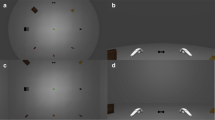Abstract
The self-reference system architecture developed to explain the retrieval of spatial knowledge from long-term memory is reviewed and expanded to include navigational tracking as one of its operations. A distinction is made between the operation of the self-reference system at a perceptual-motor and a representational level, and a case is made that if a representational self-reference system is to function as a navigational tracking device, it must be closely connected with the perceptual-motor level. Existing empirical evidence is reviewed and new empirical evidence is reported that explores the connections between the two levels of functioning. Additionally, the operations that would enable a self-reference system to function as a tracking device are derived from an animal model of sense of direction. The ideas explored in this manuscript rely on the premise that spatial memory systems evolved in the service of spatial navigation.
Access this chapter
Tax calculation will be finalised at checkout
Purchases are for personal use only
Preview
Unable to display preview. Download preview PDF.
Similar content being viewed by others
References
Clark, H. H. (1973). Space, time, semantics, and the child. In T. E. Moore (Ed.), Cognitive development and the acquisition of language. New York: Academic Press.
Easton, R. D., & Sholl, M. J. (1995). Object-array structure, frames of reference, and retrieval of spatial knowledge. Journal of Experimental Psychology: Learning, Memory, and Cognition, 21, 483–500.
Franklin, N., Henkel, L. A., & Zangas, T. (1995). Parsing surrounding space into regions. Memory and Cognition, 23, 397–407.
Franklin, N., & Tversky, B. (1990). Searching imagined environments. Journal of Experimental Psychology: General, 119, 63–76.
Gallistel, C. R. (1990). The organization of learning. Cambridge, MA: MIT Press.
Loomis, J. M., Klatzky, R. L., Gollege, R. G., Cincinelli, J. G., Pellegrino, J. W., & Fry, P. A. (1993). Nonvisual navigation by blind and sighted: Assessment of path integration ability. Journal of Experimental Psychology: General, 122, 73–91.
May, M. (2000, November). Imaginal repositioning in space: Transformation versus interference accounts. Paper presented at the Annual Meeting of the Psychonomic Society, New Orleans.
McNaughton, B. L., Chen, L. L., & Markus, E. J. (1991). “Dead reckoning,” landmark learning, and the sense of direction: A neurophysiological and computational hypothesis. Journal of Cognitive Neuroscience, 3, 190–202.
Paillard, J. (1991). Motor and representational framing of space. In J. Paillard (Ed.), Brain and space (pp. 163–182). Oxford: Oxford University Press.
Pellegrino, J. W., & Kail, R.J. (1982). Process analysis of spatial aptitude. In R. J. Sternberg (Ed.), Advances in the psychology of human intelligence (pp. 311–365). Hillsdale, NJ: Erlbaum.
Poltrock, S. E., & Brown, P. (1984). Individual differences in visual imagery and spatial ability. Intelligence, 8, 93–138.
Rieser, J. J. (1989). Access to knowledge of spatial structure at novel points of observation. Journal of Experimental Psychology: Learning, Memory, and Cognition, 15, 173–188.
Shepard, R. N., & Hurwitz, S. (1984). Upward direction, mental rotation, and discrimination of left and right turns in maps. Cognition, 18, 161–193.
Sholl, M. J. (1987). Cognitive maps as orienting schemata. Journal of Experimental Psychology: Learning, Memory, and Cognition, 13, 615–628.
Sholl, M. J. (1995). The representation and retrieval of map and environment knowledge. Geographical systems, 2, 177–195.
Sholl, M. J. (2000). The functional separability of self-reference and object-to-object systems in spatial memory. In S. O’Nuallain. (Ed.), Spatial Cognition: Foundations and Applications: Proceedings of the Mind III, Annual Conference of the Cognitive Science Society of Ireland, 1998. (pp. 45–67). Amsterdam: John Benjamins Publishing.
Sholl, M. J., & Nolin, T. L. (1997). Orientation specificity in representations of place. Journal of Experimental Psychology: Learning, Memory, and Cognition, 23, 1494–1507.
Author information
Authors and Affiliations
Editor information
Editors and Affiliations
Rights and permissions
Copyright information
© 2001 Springer-Verlag Berlin Heidelberg
About this paper
Cite this paper
Jeanne Sholl, M. (2001). The Role of a Self-Reference System in Spatial Navigation. In: Montello, D.R. (eds) Spatial Information Theory. COSIT 2001. Lecture Notes in Computer Science, vol 2205. Springer, Berlin, Heidelberg. https://doi.org/10.1007/3-540-45424-1_15
Download citation
DOI: https://doi.org/10.1007/3-540-45424-1_15
Published:
Publisher Name: Springer, Berlin, Heidelberg
Print ISBN: 978-3-540-42613-4
Online ISBN: 978-3-540-45424-3
eBook Packages: Springer Book Archive



